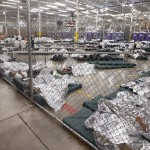2013 Budget Cuts Still Forcing Adjustments For Court Facilities
Child-Immigration Crisis Also A Civil Court Crisis

As reported by NPR: Detainees sleep and watch television in a holding cell where hundreds of mostly Central American immigrant children are being processed at a U.S. Customs facility in Nogales, Texas.
Background: National Public Radio and others are drawing attention to the fact that, over the past nine months, “… more than 50,000 children and teenagers have crossed that border illegally on their own, most from Central America. By law, the administration can’t deport those young people until they have an immigration hearing — a process that can take years.” The immigration law is different for people from Mexico, who can be returned much faster.
That means what we’re seeing is really a high-profile example of what happens when civil courts can’t meet demands. There is very likely a similar situation in many of our family courts and other systems, and those will eventually bring their own “crisis” headlines.
Here’s the NPR report: Obama To Ask Congress For $2B To Ease Immigration Crisis
NYT Shines Light On Civil Detainee Labor
The NYT notes that the federal government has become the largest employer of potentially illegal immigrants: “Last year, at least 60,000 immigrants worked in the federal government’s nationwide patchwork of detention centers — more than worked for any other single employer in the country, according to data from United States Immigration and Customs Enforcement, known as ICE. The cheap labor, 13 cents an hour, saves the government and the private companies $40 million or more a year by allowing them to avoid paying outside contractors the $7.25 federal minimum wage. Some immigrants held at county jails work for free, or are paid with sodas or candy bars, while also providing services like meal preparation for other government institutions.”